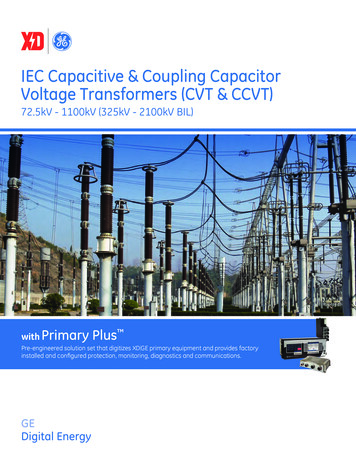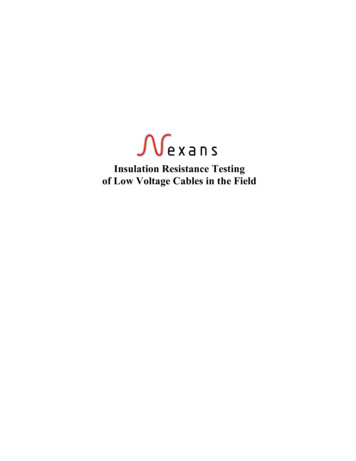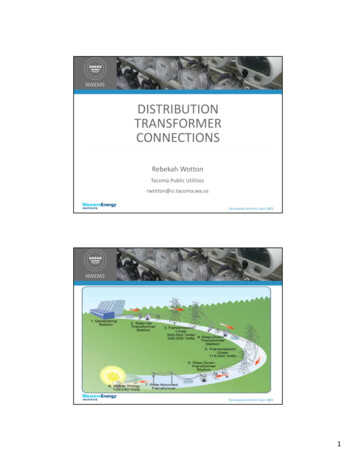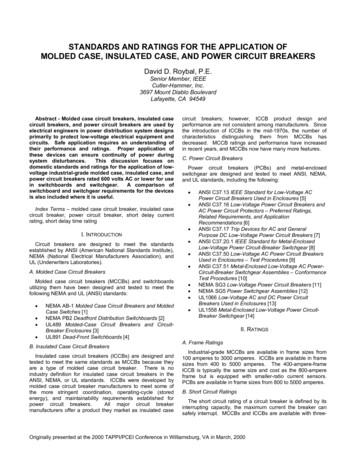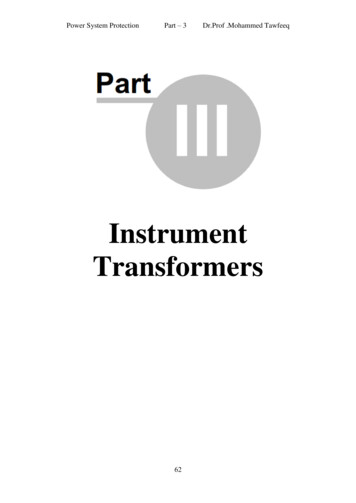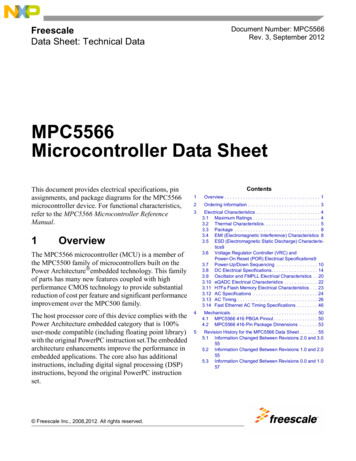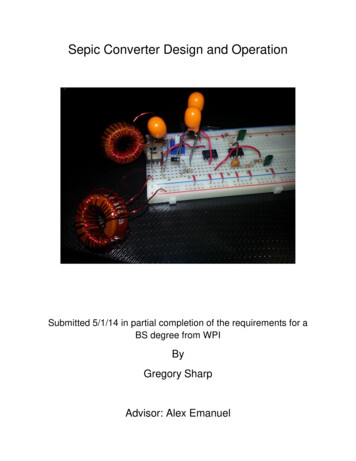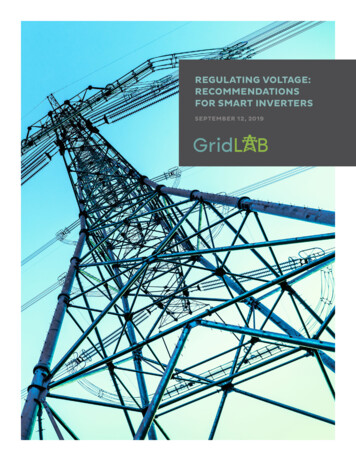
Transcription
REGULATING VOLTAGE:RECOMMENDATIONSFOR SMART INVERTERSSEPTEMBER 12, 2019
TABLE OF CONTENTS1 Introduction32 An Introduction to Voltage Regulation43 Voltage Regulation — Lessons Learned74 Recommendations9
1 INTRODUCTIONCustomers are increasingly choosing to deploydistributed energy resources (DER) to better servetheir energy needs. This deployment of DER is partof a broader energy transition where the centralizedparadigm of energy delivery is evolving to a moredistributed and decentralized future. Utilities mustmaintain reliability on the distribution grid and areconcerned about the system impacts of this transition,but the pace of change does not appear to be slowing.New technologies including solar photovoltaics withsmart inverters, battery energy storage, and internetconnected appliances are responding to the needsof the grid in new ways. A new technical standardfor interconnecting distributed energy resources,IEEE Std 1547 — 2018, was approved in 2018, andsmart inverters based on this standard are expectedto be available in 2020-2021. Customers, technologydevelopers, and utilities are currently working toestablish the guidelines for deploying this newequipment.the utilities to maintain grid reliability with the needs ofcustomers to maximize the return on their investment intheir generation. Realizing that larger systems may needmore customized settings, we focus on mass-marketSolar PV and PV plus battery systems.The motivation for making these recommendationsare twofold. First, it is beneficial for manufacturers,developers and all industry participants to harmonizesettings across jurisdictions as much as possible.Second, although the new IEEE 1547 standard requiresthe ability of inverters to communicate, it is ouropinion that communications may not be necessaryfor mass market systems. Therefore it is important toestablish settings that can address both current andfuture system requirements without the need for costlycommunications to update settings.The new smart inverters are designed to allow customersited generation to act more in concert with the existinggrid, with key features making these devices more gridfriendly than their predecessors. These features includesupport for grid reliability, voltage management, andinteractive communications. This paper focuses onthe ability of smart inverters to contribute to voltageregulation. The IEEE standard is not prescriptive asto how smart inverters shall support grid voltagemanagement, instead it requires a set of capabilitiesthat smart inverters could utilize to support voltagemanagement. The interconnecting utility and statepublic utility commissions are responsible for decidinghow exactly DER with smart inverters should behave onthe grid.This paper aims to educate utilities, developers, andstate regulators on the voltage regulation optionsavailable under the new IEEE standard, and makesrecommendations based on the experience of statesand utilities that have deployed early versions of smartinverters. Our recommendations balance the needs ofGRIDLABREGULATING VOLTAGE: RECOMMENDATIONS FOR SMART INVERTERS3
2 AN INTRODUCTIONTO VOLTAGEREGULATIONUtilities have been managing voltage on distributioncircuits for decades, through a variety of devices andmethods. Utilities have a requirement to maintainvoltage within a given range according to an ANSIstandard, while some states have more specificrequirements.1 Voltages that fall out of this rangefor extended periods of time can damage customerequipment, and voltages that are consistently highmay lead to increased load and customers using moreelectricity than necessary.Voltages typically decrease on a circuit further from thesubstation, and can fluctuate as large loads are turnedoff and on. Utilities deploy equipment such as load tapchangers, line regulators, and capacitors to maintainvoltages within target ranges. In addition, utilities areoften deploying integrated volt-var systems to moretightly maintain circuit voltage for conservation voltagereduction, which maintain the voltage closer to thelower end of the ANSI range over the entire circuit. Thisreduces overall electricity use, saving customers money.SUBSTATIONEND OF FEEDERFeederInjected PowerINVERTERLARGE PVVoltage Profile After PVVOLTAGESUBSTATIONDISTANCEACTIVE (REAL) POWER (P) Does the actual work, such as heating a coil,creating light in an incandescent bulb or rotating amotor. Measured in watts (W), kilowatts (kW) or megawatts(MW). Represents the component of the current that is insync with the voltage.REACTIVE POWER (Q) Energizes the magnetic field but does no actualwork. Represents the component of the current that is outof sync with the voltage.Voltage ProfileBefore PVAPPARENT POWER (S)END OF FEEDERDeploying distributed generation on distribution circuitshas a voltage impact. Generation will typically raisethe voltage of the circuit as it generates, with morevoltage impact from larger generators or many smallergenerators. Generators will have more impact whengenerating at maximum output coinciding with low1REAL VS. REACTIVE POWER Measured in volt-ampere-reactive (var), kilovoltampere reactive (kvar) or megavolt-ampere-reactive(Mvar).ANSI Range A Upper LimitANSI Range ALower Limitcustomer demand. As more distributed generationis deployed, it can affect the voltage of the primarydistribution circuit, and require the utilities voltageregulation devices to operate more frequently. Newersmart inverters (based on the updated IEEE 1547standard) will offer new ways to help manage theirimpact on distribution circuits. The challenge for utilitiesis to configure smart inverter capabilities such thatthey work in concert with existing voltage managementequipment. Combination (root sum squared) of active andreactive power. Measured in volt-ampere (VA), kilovolt-ampere (kVA)or megavolt-ampere (MVA).POWER FACTOR (PF) Ratio of the real power to the apparent power. UnityPower Factor (1.0) is all real power, with no reactivepower. Calculated as the cosine of the angle between thecurrent and voltage waveforms.American National Standards Institute (ANSI) C84.1 is the voltage standard.GRIDLABREGULATING VOLTAGE: RECOMMENDATIONS FOR SMART INVERTERS4
HOW REACTIVE POWER IMPACTS VOLTAGEReactive power management is an essential part ofhow voltage levels are controlled in the electric powersystem. In effect, reactive power can be injected as ameans of raising voltage levels or absorbed as a meansof lowering the voltage. Managing reactive power onthe electric system is a daily challenge for operatorsas system reactive requirements vary throughout theday due to changes in the load type and levels and thegeneration mix. Requirements and penalties on largercustomers motivate them to maintain a minimum powerfactor which also acts to manage reactive power.The primary traditional means to control voltageon the distribution system using reactive power is toswitch capacitors either at the substation or along thedistribution feeder. This is to counteract the voltagedrop from the substation along the feeder due to theload current. Inverter-based generation from solar orbatteries will typically raise the voltage on the circuitas they inject real power. Smart inverters can reducethis voltage impact by absorbing reactive power. Smartinverters, which have the ability to more quickly controlreactive power, can be better suited than traditionaldevices at mitigating voltage swells and sags that resultfrom variability of load and solar generation.ADVANCED INVERTER SETTINGS FORVOLTAGE REGULATIONIEEE Std 1547-2018 requires control modes forsupporting voltage regulation on distribution systems.The following four modes utilize reactive power to helpmanage voltage: CONSTANT REACTIVE POWER MODE: Generationmaintains a constant reactive power (either injectionor absorption).IEEE Std 1547-2018 also requires Voltage-activepower (volt-watt) capability which limits active powerproduction based on the distribution system voltagefollowing a specified response “curve.” While thereactive power modes above are mutually exclusive, voltwatt mode may be enabled in conjunction with one ofthe reactive power modes.It is also important to note that the reactive powerrequired to be injected or absorbed is limited by thereactive power capability of the smart inverter. Therevised standard uses the term “normal operatingperformance category” (A or B) to specify the requiredamount of reactive power capability. Smart invertersused by solar and battery systems should be capable ofmeeting the more stringent performance category B,which requires the capability to inject and absorb 44%of the nameplate apparent power rating (equivalent toapproximately 0.9 power factor).IEEE Std 1547-2018 requires that active powergeneration not constrain reactive power operation (alsoknown as “reactive power priority”). This could result inactive power curtailment when real power production isat or near the nameplate rating of the generator.Most evaluations and local standards to date havefocused on the reactive power modes of constant powerfactor or volt-var, with volt-watt being considered as abackup to the reactive power modes. Below are some ofthe advantages and disadvantages of these modes: CONSTANT POWER FACTOR MODE: Generationoperates with a fixed power factor (typically 0.95– 0.98 leading PF) such that reactive power isproportional to active power generated. Unity PF isthe default setting in 1547-2018. VOLTAGE-REACTIVE POWER (VOLT-VAR) MODE:Reactive power output is based on the distributionsystem voltage following a specified volt-var response“curve” which typically would have a deadbandaround the target voltage where no reactive power isinjected or absorbed. ACTIVE POWER-REACTIVE POWER (WATT-VAR)MODE: Reactive power injection or absorptionis based on active power injection or absorptionfollowing a specified watt-var “curve.”GRIDLABREGULATING VOLTAGE: RECOMMENDATIONS FOR SMART INVERTERS5
CONSTANT POWER FACTOR MODEADVANTAGES Simple to configure Can increase feeder hosting capacity bymitigating generator voltage impactsDISADVANTAGES Does not mitigate generator impacts onvoltage if set at unity (default setting in IEEEStd 1547-2018) If set to non-unity, reactive power will beinjected or (typically) absorbed at times whenit is not needed placing an unnecessaryreactive power burden on the utility system andgenerator. Can result in the need to curtail active powerproduction if the smart inverter(s) does nothave enough reactive power “headroom” May be challenging to coordinate with existingvoltage regulation equipment Typically configured to only mitigate highvoltage conditions.VOLTAGE-REACTIVE POWER (VOLT-VAR)MODEADVANTAGES Can increase distribution circuit hostingcapacity by mitigating generator voltageimpacts Injects or absorbs reactive power to helpmitigate both low and high voltages Does not inject or absorb reactive power whenvoltage is normalDISADVANTAGE Can result in the need to curtail active powerproduction if the smart inverter(s) does nothave enough reactive power “headroom” May be challenging to coordinate with existingvoltage regulation equipmentVOLTAGE-ACTIVE POWER (VOLT-WATT)MODEADVANTAGES Functions well to directly mitigate voltageimpacts from generators or high voltagecaused by temporary reconfiguration ofdistribution circuit. Can increase circuit hosting capacity. Beneficial for keeping DER online duringabnormal circuit configurations.DISADVANTAGE Can result in higher risk of active powercurtailmentGRIDLABREGULATING VOLTAGE: RECOMMENDATIONS FOR SMART INVERTERS6
3 VOLTAGEREGULATION —LESSONS LEARNEDThere have been many studies and demonstrationprojects confirming the effectiveness of advancedinverters for local voltage regulation. Studies haveanalyzed the effectiveness of different voltage regulationapproaches, such as volt-var or fixed power factor. Forexample, Arizona Public Service’s 2016 Solar PartnersProgram demonstrated that voltage issues were bestmitigated at the residential customer level usingvolt-var. Advanced inverters followed the requestedfunctions very accurately, did not conflict with traditionalregulating equipment, and demonstrated the potentialto substantially increase hosting capacity limitations.2 A2016 study by San Diego Gas & Electric and SolarCityshowed that volt-var control can significantly flattenvoltage profiles, reduce voltage variability, and inject orabsorb significantly less reactive power compared to afixed power factor setting.3Many jurisdictions with varying levels of PV penetrationsrecognize the value of volt-var with reactive powerpriority. Hawaiian Electric Company (HECO), withthe highest penetration of PV in the U.S., requires theactivation of volt-var with reactive power priority andoffers volt-watt activation as an option for customerswho would otherwise be required to pay for aninterconnection review or system upgrades. California’sRule 21 requires interconnecting PV systems to activatevolt-var and, effective July 2018, activate reactive powerpriority and volt-watt effective February 2019. The IllinoisCommerce Commission (ICC) requires the activation ofvolt-var with reactive power priority for non-residentialPV systems to be eligible for a 250/kW smart inverterrebate.4 The Australian Energy Market Operator recentlyrecommended changes to its performance standardsto require the activation of volt-var to help manage itsrapidly increasing penetrations of distributed PV.52 EPRI, “Arizona Public Service Solar Partner Program: AdvancedInverter Demonstration Results”, 2017, 11316/?lang en3 F. Bell, A. Nguyen, M. McCarty, K. Atef, T. Bialek, “Secondary Voltage andReactive Power Support via Smart Inverters on a High-Penetration DistributedPhotovoltaic Circuit”, September, 2016.4 ICC Dockets 18-0537 and 18-07535 AEMO, “Technical Integration of Distributed Energy Resources - ImprovingDER Capabilities to Benefit Consumers and the Power System”, April, 2019.GRIDLABVOLT-VAR AFFECTING OUTPUTActivation of volt-var with reactive power prioritymay raise concerns about the potential for realpower curtailment. While it is very difficult to predictif a particular location will experience high voltageconditions and to quantify the risk of loss of PV energyproduction, recent simulations and field pilot studiessuggest that the risk of real power curtailment, in mostcases, is negligible. For example, NREL’s work withHECO demonstrated that the activation of volt-var withreactive power priority results in average curtailment ofless than 0.5% during high voltage periods.6The risk of real power curtailment from volt-var is lowsince it requires the simultaneous conditions of PVoutput at maximum rating and local voltage deviationsoutside the target range. Solar systems typically onlyoperate at full output for a few hours a day in sunnymonths. As described previously, distribution systems aredesigned to maintain voltages within the ANSI range. Ifdeviations outside the range occur, distribution systemsmay be able to adjust within minutes to restore voltageto the desired range. In summary, the conditions leadingto real power curtailment from volt-var will rarely occurand, if they do, should not last long. In addition, solarowners can oversize their inverters to allow for headroomfor reactive power, without losing real power output.COORDINATION WITH EXISTING VOLTAGEMANAGEMENTAutonomous injection or absorption of reactive powerfrom volt-var also raises concerns from some utilitiesabout coordination with existing voltage regulation,particularly schemes for voltage optimization (VO) orconservation voltage reduction (CVR). NREL’s 2016analysis of select PG&E and HECO circuits found anincrease in energy savings from CVR with autonomous6 J. Giraldez, A. Hoke, P. Gotseff, N. Wunder, M. Blonsky, M. Emmanuel,A Latif, E. Ifuku, M. Asano, T. Aukai, R. Sasaki, “Advanced Inverter VoltageControls: Simulation and Field Pilot Findings”, October, 2018.REGULATING VOLTAGE: RECOMMENDATIONS FOR SMART INVERTERS7
DEFAULT CATEGORY B VOLT-VAR SETTINGS IN IEEE 1547V1 92.0%Q1 44%ANSI voltage range A(114-126 V or 95% - 105%) 44%V3 102.0%Q3 0%REACTIVEPOWER (Q)smart inverter volt-VARcontrol.7 Ameren Illinois8 andComEd9 recently publishedstudy results concluding thatsmart inverters with voltvar will have a negligibleimpact on their ongoingVO programs. ArizonaPublic Service and EPRIare investigating the mosteffective way to combineadvanced inverters with anexisting integrated volt-varcontrol (IVVC) scheme.V3 98.0%Q3 0%VOLTAGE (V)NOMINALVOLTAGE(120V)-44%V4 108.0%Q4 -44%EXPERIENCE WITHVOLT-WATTBased on experience in Hawaii, NREL recommendsVolt-watt as a “backstop” to occasional high voltagesoutside of ANSI ranges.10 The benefit is that the amountof analysis needed to interconnect DER will be reduced ifconcerns about occasional high voltages are addressedby requiring volt-watt. Various NREL studies have foundthe curtailment risk to be insignificant and that rarecases of consistent high voltages causing significantcurtailment are caused by pre-existing issues that theutility has an obligation to address.7 F. Ding et al., “Photovoltaic Impact Assessment of Smart Inverter Volt-VARControl on Distribution SystemConservation Voltage Reduction and PowerQuality,” Technical Report NREL/TP-5D00- 67296,December 2016.8 “AIC Smart Inverter Volt/Var Setting Impact on VO”, Ameren Illinois, July 31,2019.9 “Report on Impact of Smart Inverters with Volt/var on ComEd’s VoltageOptimization Program”, ComEd, August 23, 201910 NREL presentation from Andy Hoke. Estimating Customer Impact of Volt-WattUsing Only Smart Meter Voltage Data” NG VOLTAGE: RECOMMENDATIONS FOR SMART INVERTERS8
4 RECOMMENDATIONSWe recommend that utilities adopt the IEEE Std1547-2018 default settings for volt-var with reactivepower priority along with performance category B forDER inverters. We base this recommendation on thefollowing points: We recommend that utilities adopt the IEEE Std 15472018 default volt-var settings. Harmonized settingsreduces the potential for confusion among equipmentmanufacturers and installers, and streamlines theinterconnection process. Extensive experience from utilities that have deployedsmart inverters shows that volt-var is able to managevoltage using the least reactive power and is the mostflexible setting.In addition to volt-var, we recommend that volt-watt beenabled, with a curve that would only start to curtailoutside of the ANSI range (1.06 pu). While volt-wattmay raise concerns around curtailment, it can providea significant “backstop” for voltage events that shouldincrease the hosting capacity of distribution circuits,as well as eliminate the need for utilities to directlycontrol distributed generation to mitigate voltage issues.Experience from HECO as well as modeling done byNREL expects curtailment from volt-watt to be minimal,with the caveat that utilities need to be vigilant aboutresolving issues on circuits with consistent voltagesabove the ANSI range. Policymakers should considerrequiring utilities to monitor and report circuit voltagedata, which is now possible using modern technologysuch as AMI. Volt-var is the most “future proof” setting that willdelay the need communications or future changes insettings as long as possible. Even in grids with low penetrations of DER, using thissetting today reduces the need to change systems inthe future. Utility concerns about adverse interactions withexisting voltage regulation equipment and adversemulti-inverter interactions are an area of activestudy and can be mitigated. Deployment ofDER will have interactions with existing voltageregulation equipment, and utility experience to datedemonstrates that volt-var settings have worked withexisting equipment. We recommend that owners and developers consideroversizing inverters to allow required reactive poweroutput without affecting real power production.GRIDLABWe recognize that these settings may not work for alldistribution systems, and utilities and/or regulatorsshould study the specifics of their system to inform theselection of preferred voltage regulation modes andsettings, but they should work for the majority.REGULATING VOLTAGE: RECOMMENDATIONS FOR SMART INVERTERS9
GridLab is a non-profit organization whichprovides comprehensive and credible technicalexpertise on the design, operation, and attributesof a flexible and dynamic grid to assist policymakers, advocates, and other energy decisionmakers to formulate and implement an effectiveenergy transformation roadmap. GridLab offerstechnical expertise, training, and a connectivityplatform for sharing information about the rapidlyevolving electric distribution grid landscape.2120 University AveBerkeley, CA 94704 thorsRic O’ConnellGridLabCurt VolkmannNew Energy AdvisorsPaul BruckeBrucke EngineeringMany thanks to our reviewers, allerrors or mistakes are the authorsAndy Hoke and David NarangNational Renewable Energy LaboratoryBrian LydicInterstate Renewable Energy CouncilPatrick DaltonICF ConsultingSteven RymshaSunRunSuggested citation:Ric O’Connell, Curt Volkmann, Paul Brucke. RegulatingVoltage: Recommendations for Smart Inverters. GridLab,2019, http://gridlab.org/publications/
IEEE Std 1547 — 2018, was approved in 2018, and smart inverters based on this standard are expected to be available in 2020-2021. Customers, technology developers, and utilities are currently working to establish the guidelines for deploying this new equipment
